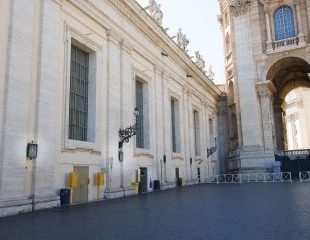
That “unknown” Via Crucis in St. Peter’s Square
A year on from Pope Francis’ memorable moment of prayer in solitude, before a silent and empty Saint Peter's Square, it has been announced that the Easter rites in the Vatican will unfortunately once again take place in the shadow of Covid.
And as in 2020, on the occasion of the next Good Friday celebrations, the humble and discreet backdrop to the Pope's testimony will be the frequently ignored 14 bronze panels depicting the Stations of the Cross, placed between the pilasters that mark the outer walls of Bernini's colonnade arms of Constantine and Charlemagne.
An almost “unknown” Via Crucis, or Way of the Cross, despite being beneath the eyes of the world; neglected by pilgrims and tourists fascinated by the more immediate and imposing beauty of the Basilica, the colonnade, the obelisk and the fountains.
Only now, in a time of pandemic, can this Via Crucis finally claim the attention it deserves, and narrate both its genesis and its creative process: this is the second casting of the Via Crucis made, in 1960, for the minor Basilica of Santa Maria di Montesanto, in Piazza del Popolo in Rome. The small seventeenth-century church has been known as the “Church of the Artists” since 1951 when Pope Pius XII assigned it as the official headquarters of the “Mass of Artists”: a community of Catholic and non-Catholic artists, mainly active in Rome, committed to reflection on sacred and liturgical art, promoted by Monsignor Ennio Francia.
The idea of decorating the church with a new Crocifisso for the high altar, made by Vittorio Di Colbertaldo, and a Via Crucis, was born at that time, involving the artists of the Association, particularly the sculptors, who were interested in this collective initiative. The names were drawn by lot, as was the assignment of the individual stations.
The panels, all of the same size and in the same bronze alloy, were produced by the Fonderia Anselmi and finished in 1960; they were then exhibited in the same year at the Campidoglio before being transferred to the Basilica of Santa Maria di Montesanto, where they are still kept today.
It was for the Holy Year of the Redemption, in 1983, that the idea of replicating the 14 stations and placing the Stations of the Cross in the prestigious setting of Saint Peter's Square was conceived. The reliefs, taken directly from the originals, were placed in the square between 1984 and 1985 in the care of the Vatican Basilica, which positioned them outside, on either side of the steps leading up to the church, visible to all and available to anyone wishing to retrace the Via Dolorosa.
It is a truly "choral" work, in which the unity of the sacred story becomes the glue between the different approaches of the 14 artists, who, each with their own style, expression and feeling, interpret the single episode of the Mystery of the Passion. The work that shows the multiplicity of forms composing figurative language at a time when, between the 1950s and 1960s, the debate raged between abstractionism and figuration, between innovation and tradition.
This artistic vitality was also sustained by the proximity, collaboration and direct knowledge of the artists, who often shared commissions, took part in the same competitions and discussed common themes.
















